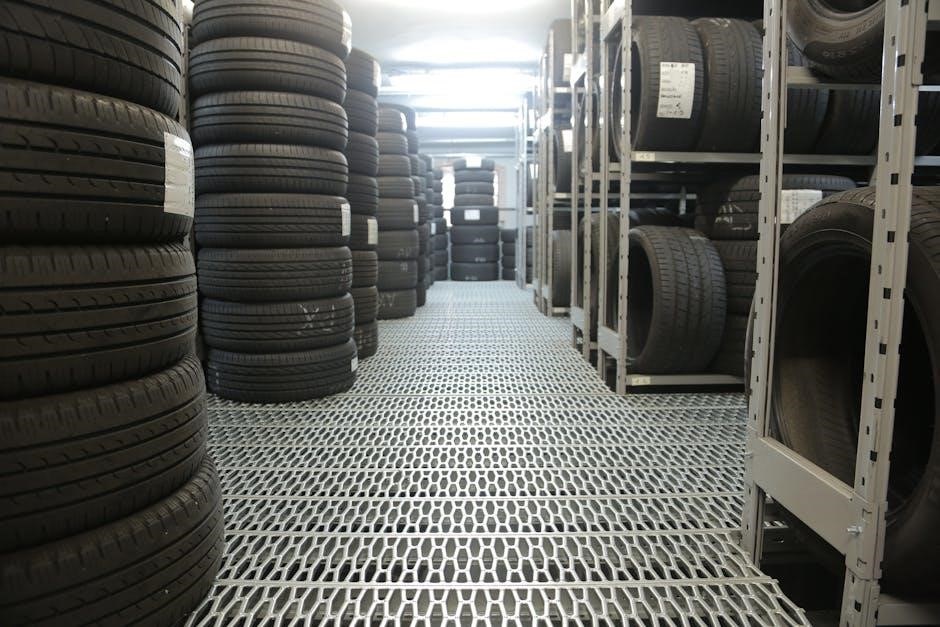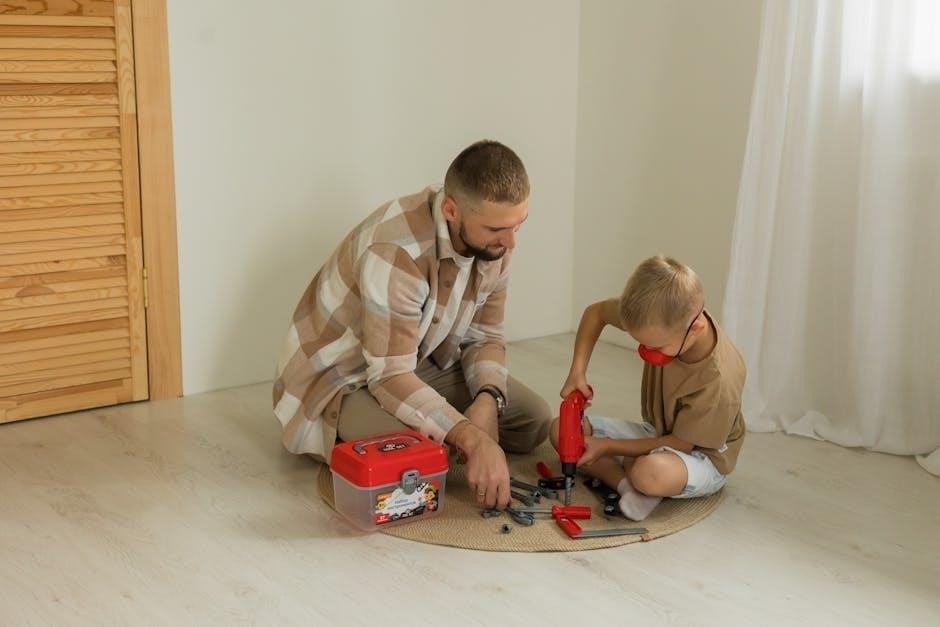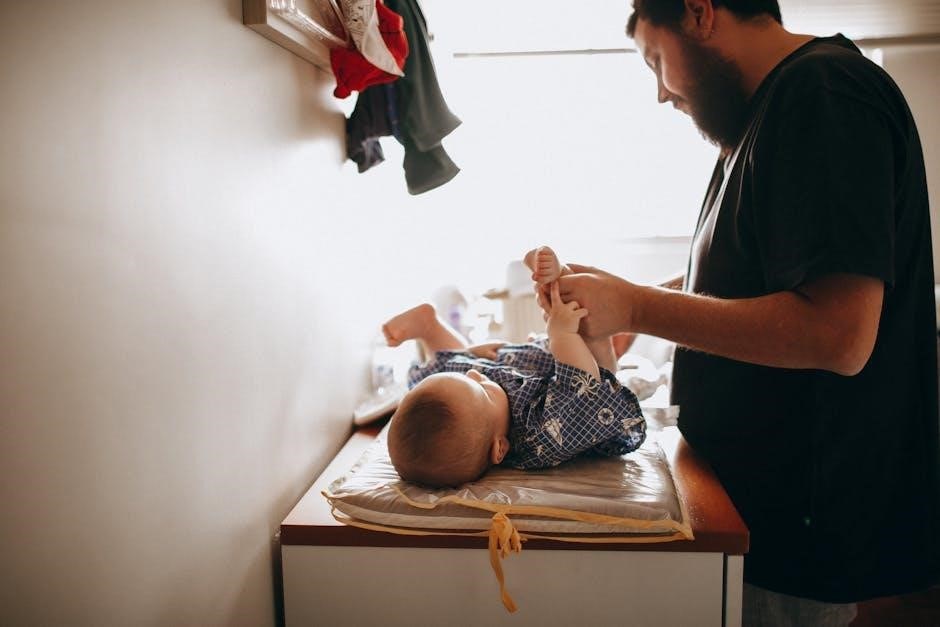Building a diaper stockpile is a smart way to prepare for your baby’s arrival, ensuring you’re never caught off guard. It helps reduce financial stress and saves time, allowing you to focus on what truly matters—your baby’s well-being. This guide will walk you through everything from understanding diaper sizes to budgeting and storage tips, ensuring you’re fully prepared for the first year and beyond.
Why Stockpile Diapers?
Stockpiling diapers is a practical way to save money and ensure a steady supply, especially during emergencies or unexpected situations. It allows parents to avoid last-minute trips to the store and take advantage of discounts when buying in bulk. Having a diaper stockpile provides peace of mind, as it guarantees that you’ll always have enough diapers on hand to meet your baby’s needs. This strategy is particularly helpful for new parents, as it reduces financial stress and ensures convenience during the first year of parenthood.
Importance of Preparation for New Parents
Preparation is key for new parents, as it helps navigate the challenges of parenthood with confidence. Stockpiling diapers ensures you’re ready for the unexpected, avoiding last-minute trips to the store. It also helps budget and save money by taking advantage of bulk discounts. Being prepared reduces stress and allows you to focus on bonding with your baby. Diaper stockpiling is a practical step that offers peace of mind, ensuring your baby’s needs are always met, no matter the situation;

Understanding Diaper Sizes
Diaper sizes vary based on baby weight, ensuring proper fit and comfort. Understanding these sizes helps in stockpiling effectively, avoiding waste, and ensuring your baby’s needs are met seamlessly.
Newborn Diapers (Up to 10 lbs)
Newborn diapers are designed for babies weighing up to 10 lbs, typically used during the first month. Stockpiling one large box (150 diapers) is recommended for the initial weeks. These diapers are essential for frequent changes, ensuring your baby stays clean and comfortable. When purchasing, check for expiration dates and consider sales to maximize savings. Having a sufficient supply prevents last-minute trips to the store during this busy time. This size is crucial for the earliest stages of your baby’s life, providing peace of mind for new parents.
Size 1 Diapers (8-14 lbs)
Size 1 diapers accommodate babies weighing 8 to 14 lbs, typically used from 1 to 2 months old. Stockpiling 2-3 large boxes (160 diapers each) is recommended. These diapers are slightly larger than newborn sizes, providing a snug fit as your baby grows. They are essential during the early stages of development, ensuring comfort and protection. Purchasing these in advance helps avoid frequent trips to the store. Focus on this size after the newborn phase to maintain a steady supply for your baby’s needs.
Size 2 Diapers (12-18 lbs)
Size 2 diapers are suitable for babies weighing 12 to 18 lbs, often used from 2 to 6 months. Stockpiling 3-4 boxes (120-140 diapers each) is advisable; This size offers a comfortable fit as your baby grows, with added protection against leaks. They are a transitional size, bridging the gap between smaller and larger diapers. Ensure you have an ample supply to cover this period, as babies tend to stay in this size longer. Prioritize this size in your stockpile to avoid frequent purchases during busy months.
Size 3 Diapers (16-28 lbs)
Size 3 diapers are designed for babies weighing 16 to 28 lbs, typically used from 6 months onward. Stockpiling 4-6 boxes (140-160 diapers each) is recommended. This size offers enhanced absorbency and comfort as your baby becomes more active. It’s a long-term size, making it a crucial part of your stockpile. Ensure you have enough to cover several months, as babies often stay in this size longer. This size is essential for overnight use and heavy wetters, making it a priority in your diaper stockpile strategy.
Size 4 Diapers (22-37 lbs)
Size 4 diapers accommodate babies from 22 to 37 lbs, often used from 12 months up to 3 years. Stockpiling 3-4 boxes (120-140 diapers each) is suggested. This size is ideal for toddlers, offering extra absorbency for overnight protection and active play. Since toddlers use fewer diapers daily, stockpile moderately but ensure enough for consistent use. Size 4 is a transitional phase, so balance quantity with your child’s growth pace to avoid waste. It’s a key size for potty training preparation and beyond.
Size 5 and 6 Diapers
Size 5 and 6 diapers cater to larger toddlers, typically weighing between 27-41 lbs and 35+ lbs, respectively. These sizes are often used for extended potty training or nighttime protection. Stockpiling 2-3 boxes (120-140 diapers each) is sufficient, as they’re less frequently needed. Size 5 and 6 diapers are ideal for older toddlers who still require extra absorbency. Consider your child’s progress with potty training when deciding how many to stockpile, as needs may vary. These sizes are less critical for newborns but essential for toddlers nearing independence.
Pull-Ups for Toilet Training
Pull-Ups are designed for toddlers transitioning from diapers to underwear, typically around 2-3 years old. They resemble underwear but offer absorbency for accidents. Stockpile 1-2 boxes (60-100 Pull-Ups) in sizes aligning with your child’s weight and progress. They’re ideal for potty training, promoting independence while providing security. Consider your child’s readiness and growth rate when deciding quantities, as needs vary. Pull-Ups are a valuable addition to your stockpile, easing the transition to independence from diapers.

Calculating Diaper Needs
Estimate daily diaper usage, considering size and age, with newborns using 10-12 diapers/day, decreasing as the baby grows. Plan for size changes and growth rates to ensure an accurate stockpile, adjusting as needed for individual variations.
Diaper Usage Per Day
Babies typically use 5 to 12 diapers daily, depending on age, weight, and size. Newborns (0-3 months) often require 10-12 diapers per day, while older babies may need fewer. Factors like feeding frequency, activity levels, and growth spurts influence daily usage. Monitoring your baby’s habits helps estimate needs accurately. Keep track of soiled diapers to adjust your stockpile accordingly, ensuring you’re always prepared without overstocking. This data is crucial for calculating the total diapers required for the first year and beyond.
Total Diapers for the First Year
A baby typically uses between 2,500 to 3,000 diapers in their first year. This estimate accounts for daily usage, size progression, and growth spurts. Factors like premature birth or faster growth may increase this number. Planning for 3,200 diapers ensures you’re prepared for unexpected needs. Distribute your stockpile across sizes 1 to 4, as these are most used during the first year. This total helps you budget and stockpile effectively, preventing last-minute purchases and financial strain.
Adjusting for Growth and Development
As your baby grows, their diaper needs will change. Monitor size transitions closely, as babies typically stay in each size for 2-4 months. Check fit regularly to ensure comfort and prevent leaks. Adjust your stockpile by purchasing smaller quantities of larger sizes, as growth spurts can be unpredictable. This flexible approach ensures you’re always prepared without overstocking sizes your baby may outgrow quickly. Regularly assess your inventory to maintain a balanced supply that matches your baby’s current needs.

Where to Buy Diapers
Diapers are widely available at popular retailers like Amazon, Walmart, and Target, as well as online platforms offering convenience and discounts. Use coupons and subscription services to save money and stock up effortlessly.
Popular Retailers
Diapers are available at major retailers like Amazon, Walmart, Target, and Costco. These stores offer a wide selection, discounts, and bulk purchasing options. Amazon is ideal for online shopping with fast delivery, while Walmart and Target provide in-store convenience. Costco and Sam’s Club are great for buying diapers in bulk at discounted rates. Many retailers also offer subscription services, ensuring a steady supply. Additionally, using store loyalty programs and apps can help maximize savings. These retailers cater to different preferences, making it easy to stockpile diapers efficiently and cost-effectively.
Online Shopping Options
Online shopping is a convenient way to stockpile diapers. Amazon offers Subscribe & Save for regular deliveries and discounts. Walmart and Target provide online bulk purchasing with free shipping. Diaper subscription services like Hello Bello ensure a steady supply. Many online retailers offer exclusive deals, coupons, and free shipping on bulk orders. This method saves time and effort, allowing you to shop from home and have diapers delivered directly to your door, making it easier to maintain your stockpile without hassle.
Using Coupons and Discounts
Maximizing savings with coupons and discounts is crucial for building a diaper stockpile. Look for manufacturer coupons on brand websites, retail apps, and weekly ads. Sign up for rewards programs like Amazon Family or Target RedCard for exclusive offers. Clip digital coupons and combine them with sales for deeper discounts. Stock up during major shopping events like Black Friday or Cyber Monday for bulk deals. Additionally, using cashback apps like Ibotta or Rakuten can provide extra savings, helping you stretch your budget further while stockpiling diapers.

When and How to Start Stockpiling
Start stockpiling diapers during pregnancy, ideally in the second trimester. Buy in bulk during sales and spread purchases over time to avoid financial strain and ensure readiness.
Starting During Pregnancy
The ideal time to begin stockpiling diapers is during pregnancy, particularly in the second trimester. This allows expectant parents to spread out expenses and take advantage of sales or discounts. Purchasing diapers in bulk during this period ensures a steady supply for the first year. It’s also a good idea to focus on smaller sizes initially, as newborns grow quickly. Additionally, storing diapers in a cool, dry place preserves their quality. This proactive approach reduces stress and financial burden after the baby arrives.
Strategies for Buying in Bulk
Buying diapers in bulk is a cost-effective strategy for stockpiling. Focus on purchasing larger sizes like 1, 2, and 3, as these are used the most. Take advantage of discounts, coupons, and subscription services to save money. Consider using Amazon gift cards or asking for them as gifts to fund your stockpile. Monitor sales cycles and buy during promotions to maximize savings. Store diapers in a cool, dry place to maintain quality. Avoid overbuying sizes your baby may outgrow quickly, and rotate stock regularly to ensure older diapers are used first.

Storing Diapers
Store diapers in a cool, dry place to maintain quality. Use space-saving solutions like shelves or bins, ensuring they’re protected from moisture and pests.
Space-Saving Storage Ideas
Maximize your space by using shelves, bins, or under-bed storage for diapers. Stackable containers or adjustable shelves can help organize supplies efficiently. Consider using a diaper caddy with compartments for easy access to essentials. Labeling storage bins ensures quick identification of sizes and types. For small areas, opt for vertical storage solutions like wall-mounted racks or hanging organizers. Rotate stock regularly to maintain freshness and accessibility. These ideas help keep your diaper stockpile tidy, ensuring you’re always prepared without cluttering your home.
Maintaining Diaper Quality
To ensure your diaper stockpile remains in great condition, store diapers in a cool, dry place away from direct sunlight and moisture. Check expiration dates, as some diapers may degrade over time. Use a first-in, first-out system to avoid expired or less effective products. Avoid stacking diapers too high, as this can cause compression damage. Keep them away from chemicals or strong odors, which might affect their quality. Regularly inspect for signs of wear or damage before use. Proper storage and rotation ensure your diapers stay fresh and ready for your baby’s needs.

Budgeting for Diaper Stockpile
Allocate a realistic budget for diapers, considering sales, discounts, and coupons. Plan ahead to avoid overspending while ensuring you have enough diapers for the first year.
Setting a Realistic Budget
A realistic budget for a diaper stockpile starts with calculating the average cost per diaper and estimating usage for the first year. Research shows diapers can range from $0.15 to $0.30 each, depending on size and brand. Plan for 2,500 to 3,000 diapers in the first year, totaling around $375 to $900. Consider sales, coupons, and bulk discounts to reduce costs. Avoid overspending by prioritizing essential sizes and avoiding unnecessary purchases. Adjust your budget based on brand preferences and growth milestones to ensure affordability and preparedness.
Tips for Saving Money
To save money on diaper stockpiling, buy in bulk during sales and use coupons or discount codes. Opt for store-brand diapers, which are often cheaper than name brands but equally effective. Consider using reusable cloth diapers for added savings. Sign up for rewards programs from retailers to earn points redeemable for diaper purchases. Additionally, use cashback apps or price-matching policies to maximize savings. Finally, ask for diaper gift cards during baby showers to help stock up without spending your own money.

Maintaining the Stockpile
Regularly monitor diaper inventory to avoid shortages or excess. Rotate stock to use older diapers first, preventing expiration. Keep storage areas clean and dry for quality preservation.
Monitoring Inventory Levels
Regularly checking your diaper stockpile ensures you never run out. Set a reminder to count diapers weekly and track usage patterns. Use a simple spreadsheet or a note-taking app to log quantities. Keep tabs on how quickly sizes are used, especially during growth spurts. Store diapers in a visible, accessible area to make monitoring easier. Rotate stock to use older diapers first, preventing expiration. This system helps maintain a balanced supply and avoids waste, giving you peace of mind as your baby grows.
Rotating Stock to Prevent Expiration
Regularly rotating your diaper stockpile ensures older diapers are used before they expire. Implement a “First In, First Out” system by placing newer diapers behind older ones. Store diapers in a cool, dry place to maintain quality. Check expiration dates periodically and prioritize using sealed packages first. Label boxes with purchase dates for easy tracking. This method prevents waste and ensures your baby always has fresh, reliable diapers available. Rotation is key to maximizing your stockpile’s effectiveness and longevity.

Tips and Tricks
Start stockpiling during pregnancy to avoid last-minute rushes. Buy diapers in bulk to save money and ensure availability. Use coupons and discounts to maximize savings. Always check expiration dates and store diapers in a cool, dry place to maintain quality. Rotate your stock regularly to use older diapers first. Keep track of sizes to avoid overstocking. Stay organized and enjoy the peace of mind that comes with being prepared.
Avoiding Common Mistakes
When building a diaper stockpile, it’s essential to avoid common pitfalls. Overbuying sizes your baby may outgrow quickly can lead to wasted money. Always check expiration dates, as some diapers have shelf lives. Store diapers in a cool, dry place to maintain quality. Don’t wait too late to start stockpiling, as unexpected delays can occur. Monitor sales cycles to avoid missing discounts. Lastly, ensure you have enough storage space before purchasing in bulk to prevent clutter and stress.
Real-Life Examples and Testimonials
Many parents swear by the convenience of diaper stockpiling. Sarah, a first-time mom, shared how having a year’s supply saved her during a tight financial month. “It was a lifesaver,” she said. Another parent, Mark, mentioned that buying in bulk during sales reduced his monthly expenses significantly. Testimonials highlight the peace of mind that comes with being prepared. Stockpiling not only saves money but also reduces the stress of last-minute trips to the store. These real-life experiences prove the practical benefits of building a diaper stockpile.

Addressing Common Concerns
Common concerns include space constraints, diaper expiration, and upfront costs. Proper storage and rotation can mitigate these issues, ensuring your stockpile remains practical and cost-effective.
Space Constraints
Space constraints are a common concern when stockpiling diapers. Use stackable containers or under-bed storage to maximize space. Consider vertical shelves or hanging organizers to keep diapers accessible without clutter. Rotate your stock regularly to ensure older diapers are used first. If space is extremely limited, focus on smaller quantities and replenish as needed. Involving family or friends with more storage capacity can also help manage larger stockpiles effectively.
Diaper Expiration and Usage
Diapers do not have expiration dates, but their quality can degrade over time. Proper storage in a cool, dry place maintains their effectiveness. Use the oldest diapers first to prevent degradation. Avoid stockpiling more than a two-year supply, as newer diapers may offer improved features. Always check diapers for signs of wear before use. Size and fit are crucial for leakage prevention. Prioritize quality and fit over quantity when stockpiling. Remember, a well-maintained stockpile ensures your baby stays comfortable and protected throughout their growth stages.
Stockpiling diapers is a thoughtful investment in your baby’s comfort and your peace of mind. With proper planning, you’ll navigate parenthood confidently, knowing you’re always prepared.
Final Thoughts on Diaper Stockpiling
Stockpiling diapers is a practical and thoughtful way to prepare for parenthood, offering peace of mind and financial relief. By planning ahead, you ensure your baby’s needs are consistently met, reducing last-minute stress. Remember, every family’s journey is unique, so tailor your stockpile to your baby’s growth and preferences. Stay organized, monitor expiration dates, and enjoy the convenience of having a well-stocked supply. With patience and consistency, you’ll navigate the first year and beyond with confidence and preparedness.
Encouragement for New Parents
Celebrate your journey into parenthood with confidence and joy! Stockpiling diapers is just one of many proactive steps you’re taking to ensure your baby’s comfort and happiness. Remember, it’s okay to ask for help and lean on your support system. Every diaper changed and every late-night feeding is a testament to your love and dedication. Embrace the chaos and cherish the moments—this time goes by quickly. You’re doing an amazing job, and your preparation is a sign of the incredible parent you’re becoming. Enjoy this beautiful journey!



